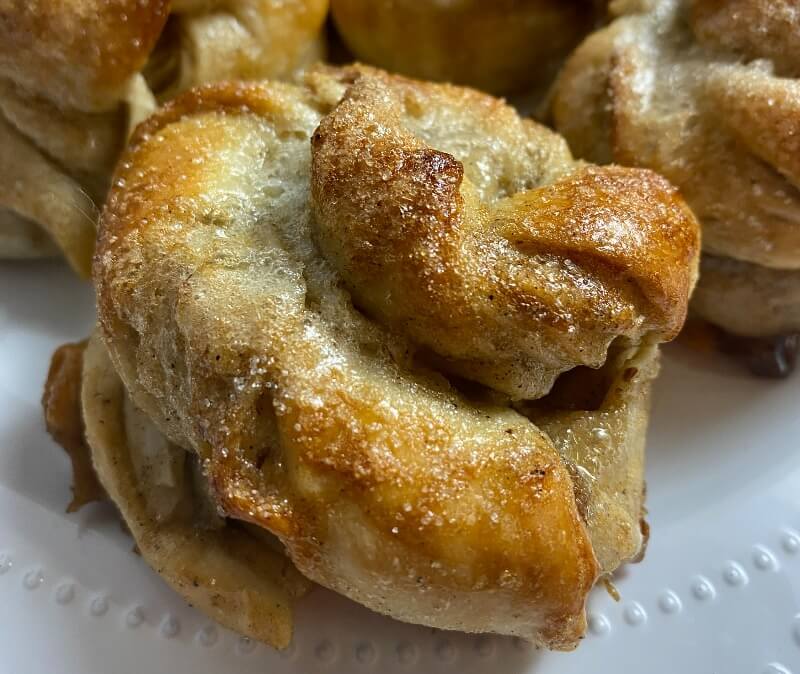
CardaMOM's Day Spiced Almond Butter Swirls
Bucket of BreadShare
Give mom a dessert fit for a queen!
Nicknamed the “queen of spices,” it has the power to enliven a baked good, to provide a lush backbone to cup after cup of milky, sweet tea, and to temper heat with a mellow hint of something in bloom.
Few flavors in this world stack up to the aromatic complexity of cardamom.
Freshly ground cardamom is best (without the pod) because most of cardamom’s fragrant essential oils are contained in the seeds and they lose potency fairly quickly once ground. If you do use ground cardamom, look at the earliest date you can grab.
Cardamom is third on the list of the most expensive spices, just after saffron and vanilla.
Cardamom is rich in essential oils and has strong antioxidant and diuretic properties.
It has an antibacterial and anti-inflammatory effect. It is said to lower blood pressure and have support good digestion because it stimulates the metabolism.
Like ginger, its cousin, cardamom could help with digestive ailments.
Some people use the spice to make a stomach-soothing tea. It may also be useful in protecting the stomach from ulcers.
- Cardamom is one of the world’s most exotic spices – along with Saffron and Vanilla.
- Cardamom belongs to the same botanical family as ginger and turmeric.
- Cardamom is also one of the world’s oldest spices – cultivated for more than 4000 years.
- It was popular in the ancient civilizations of Rome, Egypt and Greece.
- The earliest references of cardamom were in ancient Sanskrit texts and the ancient Sumer civilization (in modern day Iraq).
- Cardamom is the ‘Doctor of Spices’. Its amazing medicinal properties are useful in alleviating several health issues.
- Cardamom accounts for 3% of the total global spice trade.
- Cardamom is a universally popular spice. It is widely employed in Indian, Middle Eastern, Arabic, and Swedish cuisine.
- Green Cardamom likely has its origins in southwest India. There is even a range called Cardamom Hills here.
- Ancient people believed cardamom had supernatural powers and that it could drive out evil spirits.
- According to Chinese tradition, the consumption of cardamom tea is the secret to long life.
- The oil from cardamom seeds may be able to kill bacteria and fungi.
- Some studies suggest that cardamom could help with some aspects of metabolic syndrome.
- While many people may think of mint and cinnamon as breath fresheners, people have used cardamom for this purpose for centuries.
Cardamom around the world:
- Hindi: Elaichi
- French: Cardamome
- German: Kardamom
- Italian: Cardamomo
- Latin: Amomum
____________________________________________
Ingredients
- Your favorite Bucket of Bread Brand Dough (We used the Traditional White).
- 1 Stick Unsalted Butter
- ½ Cup Light Brown Sugar
- 2 Tbsp White Sugar
- 2 Tbsp Cardamom
- 1 Tsp Salt
- 1/4 Cup Thinly sliced almonds
Instructions
- Preheat oven to 400 F.
- Mix thoroughly 1 stick butter, brown sugar, white sugar, cardaMOM, and salt.

-
Roll out a bit of dough from your kit to be the size of about 8 1/2 x 11 (sheet of typing paper).

-
Trim up the edges (you can bake these up later with remnants of the sweet butter spread).

-
Spread out the butter mixture out onto the rectangle evenly to the edges.

-
Add some thinly sliced almonds.

-
Fold up the bottom to almost the middle. Fold down the top too.

-
Gently roll out the folded dough again.

-
Cut evenly long ways.

-
Twist everything up.

-
Roll the twists onto themselves into a circular pattern.

-
Tuck and pinch to ensure the rolls hold up.

-
Bake at 400 F for about 10 mins.

-
Separate an egg from the yolk.

-
Remove from the oven and brush with egg whites.

-
Sprinkle white sugar onto the egg whites.

-
Continue baking for about 10 mins or until the color is golden brown.

-
Let cool for a few minutes. Serve warm. Enjoy!

For a ton More Recipes
Visit the recipe section at BUCKETOFBREAD.COM!
